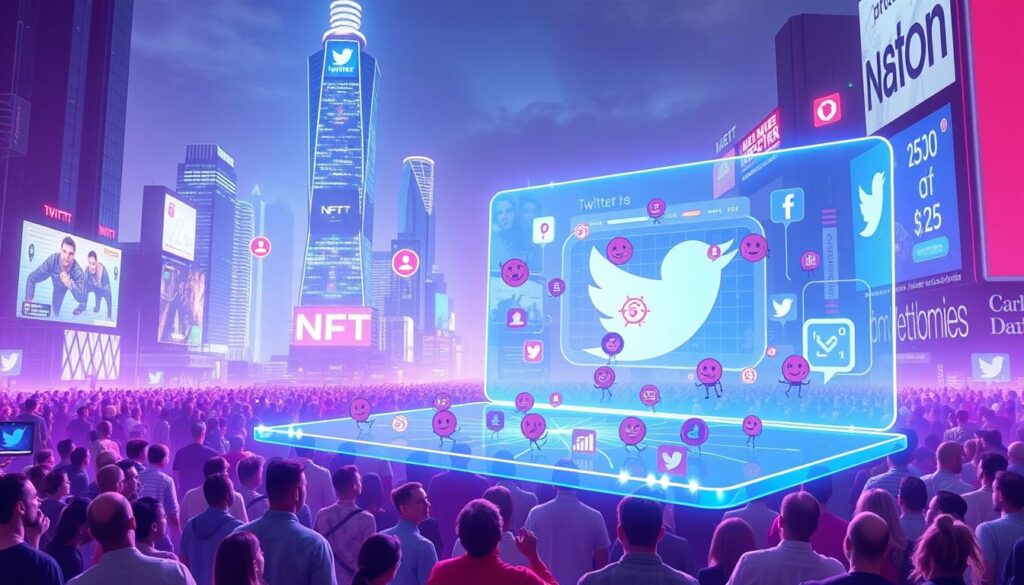Now Reading: NFT Intellectual Property: Laws & Ownership Guide
- 01
NFT Intellectual Property: Laws & Ownership Guide
NFT Intellectual Property: Laws & Ownership Guide
Digital collectibles exploded into mainstream culture in 2017 with CryptoKitties, a blockchain game where users bred and traded unique virtual cats. This marked the start of a new era for ownership in the digital realm. By 2021, artworks like Beeple’s $69 million sale at Christie’s and NBA Top Shot’s $500 million milestone proved these tokens had evolved into serious financial assets.

Blockchain-based tokens represent more than just art or tweets—they’re programmable contracts tied to specific rules. While buyers often assume they own full rights to the attached content, legal protections work differently here. The code embedded in each token usually defines what you can—and can’t—do with the linked asset.
This guide breaks down how traditional ownership frameworks collide with decentralized technology. You’ll learn why purchasing a token doesn’t automatically grant copyright control and how creators retain certain privileges. We’ll also explore landmark cases shaping enforcement strategies and highlight practical steps to safeguard your interests.
Key Takeaways
- Owning a digital token doesn’t guarantee rights to its associated content
- Smart contracts define usage permissions, not traditional legal agreements
- Copyright and trademark laws apply differently to blockchain assets
- Record-breaking sales highlight both opportunities and legal gray areas
- Clear documentation is critical for resolving ownership disputes
Understanding NFT Intellectual Property and Its Legal Landscape
Blockchain-based certificates revolutionized how we verify authenticity in virtual spaces. These unique cryptographic units create provable scarcity for digital items, from artwork to virtual real estate. Unlike traditional files that copy endlessly, each token acts as an unforgeable receipt tied to specific content.

Defining Unique Attributes of Cryptographic Tokens
Non-fungible tokens (NFTs) store metadata in smart contracts – self-executing code defining ownership rules. This tech enables automatic royalty payments and tracks provenance across marketplaces. For example, a musician could program 10% of secondary sales to flow back indefinitely.
Three core features separate these tokens from regular files:
- Immutable blockchain records prevent tampering
- Transparent transaction histories build trust
- Programmable rights management controls usage
Modernizing Traditional Ownership Concepts
Legal systems face challenges applying copyright laws to decentralized assets. Purchasing a token often grants bragging rights, not reproduction privileges. A buyer might own the digital certificate but need separate licenses for commercial use.
Recent U.S. guidelines confirm existing laws still apply. Creators retain copyright unless contracts explicitly transfer it. This distinction between owning the token and controlling the linked content remains critical for avoiding disputes.
History and Evolution of NFTs
The concept of blockchain-based collectibles began quietly in 2012 but remained obscure for years. Everything changed when digital cats crashed Ethereum’s network.
Early Milestones and the Rise of CryptoKitties
Dapper Labs’ 2017 release of CryptoKitties transformed digital ownership. These breedable cartoon felines demonstrated how blockchain could create scarcity for virtual items. Each cat carried unique genetic code stored on-chain, allowing owners to trade or combine traits.
The game’s popularity exposed Ethereum’s limitations. Transaction fees skyrocketed as users flooded the network, proving decentralized systems needed scaling solutions. Three key lessons emerged:
- Programmable assets could drive mainstream adoption
- Blockchain networks required better infrastructure
- Commercial rights could be embedded in code
Notable Sales and Record-Breaking Events
Beeple’s $69 million Christie’s auction in March 2021 shattered perceptions. Traditional art institutions suddenly embraced blockchain certificates. That same year, Twitter founder Jack Dorsey sold his first tweet for $2.9 million, while NBA Top Shot generated $500 million from basketball clip trades.
By December 2021, global monthly trades hit $25 billion. These milestones revealed new possibilities:
- Digital artists gained direct monetization channels
- Sports franchises unlocked revenue from highlight reels
- Social media history became collectible
The Core Mechanics of NFT Intellectual Property
Technology reshapes how we establish and transfer rights in virtual spaces. At its core, blockchain-based certificates rely on two pillars: self-executing agreements and cryptographic verification. These systems automate trust while maintaining transparent records of transactions.
Smart Contracts and Blockchain Authentication
Programmable agreements form the operational framework for digital collectibles. These coded contracts define usage permissions, royalty structures, and transfer conditions. For example, a 10% resale fee might automatically route to creators whenever ownership changes hands.

Blockchain networks provide tamper-proof validation of these transactions. Every exchange gets recorded across multiple nodes, creating an unbroken chain of custody. This process eliminates third-party intermediaries while ensuring permanent audit trails.
Linking Digital Assets to Ownership Rights
Cryptographic hashing bridges tokens with their associated content. Mathematical algorithms generate unique identifiers – like digital fingerprints – that connect certificates to specific files. These hashes verify authenticity without storing entire artworks on-chain.
Three critical distinctions shape ownership:
- Tokens represent proof of ownership, not necessarily copyright
- Hashes authenticate relationships but don’t host content
- Royalty mechanisms operate independently of traditional licensing
Understanding this separation helps buyers recognize what they’re actually purchasing. The blockchain confirms transaction legitimacy, while separate agreements govern content usage rights.
NFT Intellectual Property in Practice
Real-world legal battles are shaping how blockchain assets interact with traditional ownership laws. Recent court decisions reveal how existing frameworks apply to emerging technologies, offering clarity for creators and buyers alike.

Case Studies: High-Profile Transactions and Legal Disputes
Luxury brand Hermès set a precedent by winning a trademark infringement case against artist Mason Rothschild’s MetaBirkin collection. The court ruled his digital designs diluted the value of the iconic Birkin handbag, even though no physical products were sold.
Other notable disputes include:
- Nike’s ongoing lawsuit against StockX over virtual “claim tickets” for sneakers
- A court applying the Rogers test to dismiss Humvee maker AM General’s case against Call of Duty’s vehicle depictions
- 2K Games successfully defending NBA player tattoos using fair use arguments
Examples of Licensing and Copyright Limitations
Owners of non-fungible tokens often face hidden restrictions. CryptoKitties’ smart contracts originally limited commercial use to $100,000 annually – a clause many buyers overlooked.
Three critical lessons emerge from recent cases:
- Copyright protections remain with creators unless explicitly transferred
- Trademark holders can challenge unauthorized virtual representations
- Courts favor artistic expression when it doesn’t confuse consumers
These rulings confirm traditional laws adapt well to blockchain innovations. Clear licensing terms and due diligence remain essential for avoiding disputes.
Monetizing Intellectual Property Through NFTs
Blockchain technology unlocks new income models for artists and businesses. Creators can sell unique digital certificates while maintaining control over their original content. This system transforms how value flows in creative industries.
Sales of Digital Assets and Underlying Rights
Purchasing a token doesn’t mean owning the artwork itself. Smart contracts determine what buyers can do with linked files. For example, NBA Top Shot collectors can display highlights but can’t sell merchandise featuring them.
Three common licensing approaches:
- Personal use only (no commercial activity)
- Limited commercial rights with revenue caps
- Full copyright transfer through separate written agreements
Royalties and Secondary Market Revenue Streams
Programmable payments create ongoing income. When a CryptoKitties token resells, 3.75% automatically goes to the original creator. This feature helps artists benefit from rising values long after initial sales.
Key advantages for businesses:
- Automatic royalty enforcement via blockchain
- Transparent revenue sharing across platforms
- Reduced administrative costs compared to traditional licensing
Companies like Dapper Labs show how to balance control and profitability. Their contracts allow moderate commercial use while protecting core business interests. Always review agreements carefully – what’s coded matters more than assumptions.
Navigating Regulatory Challenges and Enforcement Strategies
Enforcing rights in blockchain ecosystems requires fresh approaches. Unlike traditional digital platforms, decentralized networks can’t delete problematic content. This permanence tests existing legal frameworks designed for eras before immutable ledgers.
Controlling Infringement on Digital Platforms
The Digital Millennium Copyright Act (DMCA) struggles with blockchain’s unchangeable nature. Marketplaces like OpenSea can delist items but can’t erase them from the chain. Courts now weigh secondary liability – holding platforms accountable if they enable or profit from unauthorized use.
Key enforcement challenges include:
- Vicarious liability claims when platforms financially benefit from infringing activity
- Contributory liability risks if companies ignore repeated violations
- Technical barriers to removing content permanently
Smart Contract Clauses and Buyer Beware Considerations
Code dictates rights in blockchain transactions. Buyers must scrutinize smart contracts for usage limits and royalty terms. Recent United States guidance confirms existing copyright laws apply, but enforcement relies on proper documentation.
For those exploring regulatory compliance strategies, three practices reduce risks:
- Verify ownership history before purchasing digital certificates
- Review embedded contract terms for commercial rights
- Monitor court rulings shaping platform responsibilities
While regulators aren’t creating new rules yet, proactive due diligence remains essential. The system works when participants understand both its power and limitations.
FAQ
How does blockchain technology impact ownership rights for digital art?
Blockchain provides a public ledger to verify authenticity and transfer history, but it doesn’t automatically grant copyright. For example, purchasing a Bored Ape Yacht Club token grants ownership of the unique token, not the underlying artwork’s commercial rights unless specified in the smart contract.
Can creators enforce royalties on secondary sales of their work?
Yes. Platforms like Ethereum-based marketplaces allow artists to embed royalty clauses in smart contracts, ensuring automatic payments for resales. However, enforcement depends on platform policies and jurisdictional laws, which vary globally.
What legal risks arise when buying tokens linked to branded content?
Unauthorized use of trademarks or copyrighted material can lead to disputes. The Hermès vs. MetaBirkins case highlighted how creating tokens inspired by branded designs without permission may result in infringement claims, even if the asset exists on-chain.
Are there real-world examples of disputes over tokenized assets?
Yes. In 2021, artist Derek Laufman sued a developer for minting his artwork without consent. Courts are increasingly addressing whether tokenization violates reproduction rights, emphasizing the need for clear licensing terms in transactions.
How do smart contracts clarify buyer responsibilities?
These self-executing agreements outline usage rights, resale conditions, and royalties. For instance, CryptoPunks specify that buyers own the art tied to their token, but commercial use requires adherence to Larva Labs’ terms.
What steps prevent unauthorized replication of digital collectibles?
Platforms like OpenSea use takedown systems for copied content, but proactive measures include watermarking files and registering copyrights. Legal action remains a tool, as seen in cases against “right-click save” minters exploiting loopholes.
Do buyers automatically gain reproduction rights for acquired tokens?
No. Unless explicitly stated in the contract, purchasing a token like Beeple’s “Everydays” doesn’t permit printing or merchandising the art. Rights remain with the creator unless transferred through a separate agreement.













